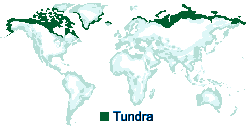
 No Trees Allowed Tundra - from the Finnish word "tunturia" meaning treeless plain or barren land - is the coldest of all the areas of living organisms. It is noted for its frost-molded landscapes, extremely low temperatures, little precipitation, poor nutrients, and short growing seasons.
Arctic tundra circles the North Pole and extends south to the treeline. Although the average winter temperature is -34°C / -30°F, the average summer temperature is 3-12°C / 37-54°F which enables the tundra to sustain life in a short growing season of 50 to 60 days.
Winters are cold and dark, and when the snow and the top layer of soils melt in the summer, the tundra is covered with wetlands - marshes, lakes, bogs and streams. These breed billions of insects that provide food for migrating birds and misery for the animals and people. Trees can't grow there - the ground is permanently frozen 1-3 feet / 30-90 cm beneath the surface and roots can't grow deep enough to keep trees upright. About 1,700 kinds of plants are able to resist the cold climate, including low shrubs, sedges, reindeer mosses, liverworts, and grasses, lichen, and 400 varieties of flowers.
Click pictures for more information and credits. Arctic Library: Arctic, Land Cold/Cold Places, Environment, Snow Arctic Maps & Weather Reports Links: Arctic, Cold Places Environment, Maps The Tundra Biome
|

|
DICTIONARY: Just "double-click" any unlinked word on this page for the definition from Merriam-Webster's Student Electronic Dictionary at Word Central. |

|
ARCTIC LIBRARY & GLOSSARY: Check this section for an index of the rest of the things you really need to know about the Arctic. |

|
ARCTIC MAPS & WEATHER REPORTS: Maps of the Northwest Passage, explorers' routes, iceberg sources, Nunavut, the Arctic by treeline, temperature... |

|
ARCTIC LINKS: Even more information! Links to sites related to the Arctic and "Iceberg: the Story of the Throps and the Squallhoots". |

|
GUIDE TO ARCTIC SUNRISE & SUNSET: How much sunlight or darkness is there in the Arctic on each day of the year? |
to is the property of their respective owners, and Athropolis is not responsible for their content.
